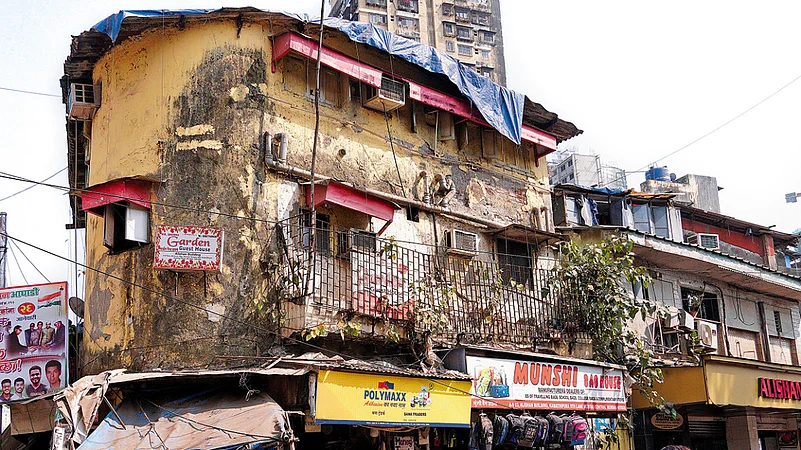Redevelopment was presented as a solution to the multiple housing issues of Mumbai in the 1990s, signalling the demise of the legal-juridical state and arrival of the facilitator state. At this time, the city had one of the world’s costliest real estate markets. It was was characterised by some of the most intractable and vexing housing issues, such as large scale overcrowded and dilapidated housing stock, more than half of the city population staying in slums and the growing unaffordability of housing. The city was also suffering from a lack of adequate public infrastructure—narrow roads, lack of parking spaces, open spaces and playgrounds, health and social infrastructure. The idea of redevelopment was thus envisaged as an instrument to build flexibility into policy, and rope in private finance through the modification of development control rules to set Mumbai on the path of becoming a world-class city.
The incentive offered to developers was in the form of FSI (floor space index) which is a ratio of built floor space to the plot area. Needless to say, the concept has not only received tremendous uptake from developers, it has become the way in which things get done in the city. Incentive FSI (FSI much above that allotted to the area by plans) and its sister instrument of TDR (transfer of development rights) that enable the execution of a project in geographies that are delinked from the original plot are today the instruments that have been used for purposes ranging from solving housing issues, such as redeveloping slums, redeveloping old buildings and renewing entire old city areas to providing essential amenities. A running joke in the city is that FSI and TDR are the currencies that power Mumbai. The Mumbai model is now being experimented with in several other Indian cities including Ahmedabad, Bangalore, Delhi and so on.
Kamathipura is the most recent entrant in the redevelopment juggernaut, though the idea of redeveloping the locality is not new. Kamathipura is an old, densely-populated, dilapidated, extremely congested, socially and economically diverse, mixed use, inner-city, largely working-class neighbourhood, located in the island-city of Mumbai. It also happens to be a deeply socially and spatially stigmatised urban space due to it being labelled as a red light area during the colonial era. It owes its name to the Kamathis, the lower caste, Telugu-speaking migrant labourers who originated from the southern Andhra region and came to Bombay in the late 1700s. Mostly male migrant labourers lived in the low-lying marshy land to the south of Bellasis Road on the periphery of the Fort City in highly cramped, substandard housing created by private landlords. Over time, they brought their families, built places of worship and other social institutions and settled into the neighbourhood. Other communities too migrated to the centrally-located neighbourhood which promised access to jobs, urban amenities and relatively affordable rental housing. European sex workers were housed in the neighbourhood by the colonial police and the area was tacitly acknowledged as a space where sex workers could entertain their customers. Since then, Kamathipura has seen little in the way of municipal improvement works, the entire area deteriorating in terms of water, sanitation, housing and open spaces.
Kamathipura has had a historically complex relationship with efforts at transforming it. In the fifties, the area was declared a slum and recommended for demolition and renewal. The locals, especially the Kamathi landlords, resisted this derogatory labelling and renewal efforts. In the eighties, the state government, via the Maharashtra Housing and Area Development Authority (MHADA) and the Mumbai Repair and Reconstruction Board (MBRB) conducted comprehensive door-to-door surveys, including brothels and shops, in order to propose a large-scale renewal project. The World Bank, however, pulled out from financing the project, citing the risks involved in getting consensus from the tenants and landlords who did not see eye to eye over the project. Around 2007, a private developer came out with fancy, large-scale plans of redevelopment and a radical proposal to rename the neighbourhood, thereby erasing its “shame” of being a red light area. This too bit the dust due a lot of contestations between landlords and tenants, both formal and informal sub-tenants over proper compensation, the lack of clarity over how much would be the sale component and profit margin for private developers, and distrust against private developers who left projects and residents in a state of limbo citing financial strains, languishing in faraway transit camps. Around 2014, the Kamathi landlords came together to form a welfare association with the intent to redevelop the neighbourhood themselves with the help of the state government. This plan too excluded many stakeholders, especially the politically-mobilised tenants and shopkeepers from the decision-making processes, and ran aground due to lack of interest from the private developers in undertaking the project during a slump in the global real estate sector.

What the history of failed, stalled, partially successful redevelopment projects in Kamathipura tells us is the slow, quiet yet violent ways in which diverse working-class neighbourhoods are being deliberately destroyed. Many of the informal work that took place in the lanes and bylanes of Kamathipura, especially various forms of waste recycling, have been wiped out. Homeless groups living in interstitial spaces have been made to feel unwelcome. Several public amenities meant for the working class have seen strategic disinvestment and then have been expropriated by private players. Brothel-based sex work too has been all but erased with landlords renting out these spaces to more lucrative small manufacturing activities while they await an imminent redevelopment. Sex workers, including those who own or rent the tiny apartments, have rarely been invited to discuss the redevelopment agenda as almost all the efforts and plans have strategically decided to exclude them and even remove them once and for all from Kamathipura. With repair works being systematically declared as untenable, many buildings have been sadly rendered uninhabitable, pushing out families to the city’s periphery. Thus the prolonged yet calculated and wilful abandonment of the neighbourhood’s built form, has in effect led to a criminalisation of Kamathipura and reinforced an urgent call for large-scale redevelopment—a call that has now unfortunately turned long-term neighbours in Kamathipura against one another and rendered sex workers both invisible in the politics of redevelopment and paradoxically blames them as impediments to the aspirations of middle-class respectability.
In 2020, the state housing minister declared that Kamathipura redevelopment would be placed on fast-track mode. The tenurial relations in Kamathipura, where more than 80 per cent buildings are covered under the Rent Control Act and where there are several layers of sub-tenancies in practice, such as the pugree system (a payment where the share of entrenched shareholders is acknowledged) are not acknowledged by law and are complex. Any redevelopment would need to resolve and simplify these complexities, which almost certainly translates into evictions of sex workers, the pavement dwellers, homeless, the recycling economies. The state of Maharashtra sees large-scale redevelopment in Mumbai as a way of reviving the economy post-Covid. The question is, do financiers and developers alike have the scale of capacities needed to do justice to this complex socio-economic fabric? Or do they simply become expendable?
(This appeared in the print edition as "Life Measured in Square Feet")
(Views expressed are personal)
ALSO READ
Amita Bhide, Ratoola Kundu work at the Centre for Urban Policy and Governance at TISS, Mumbai





















